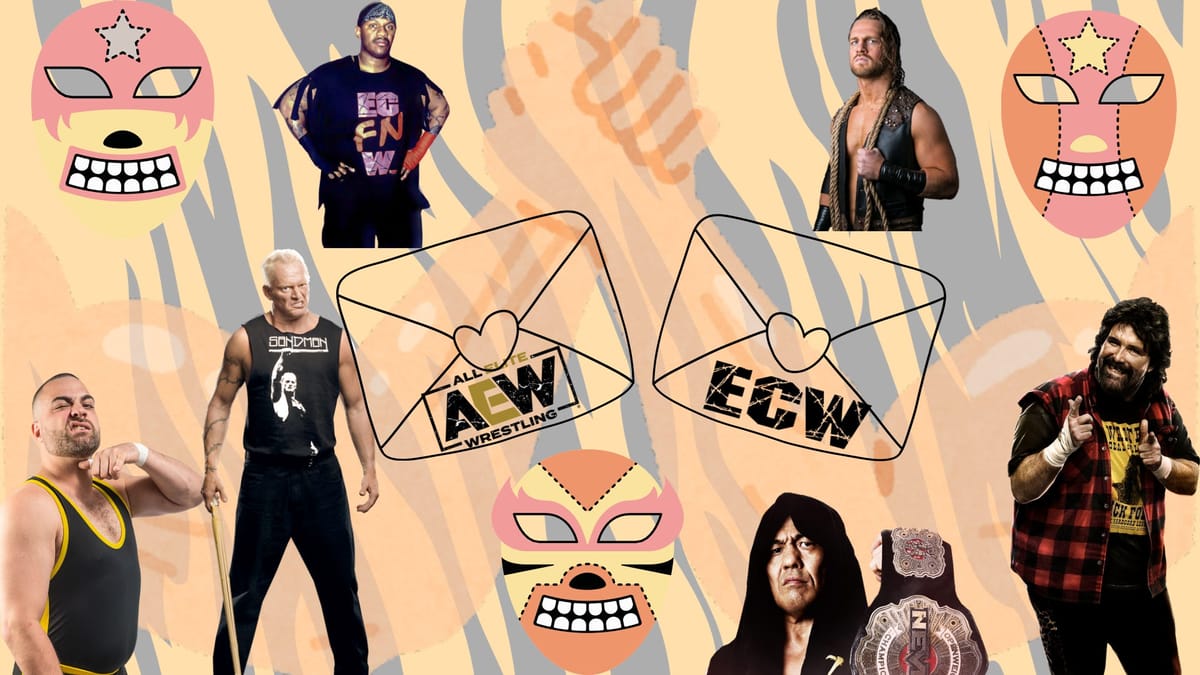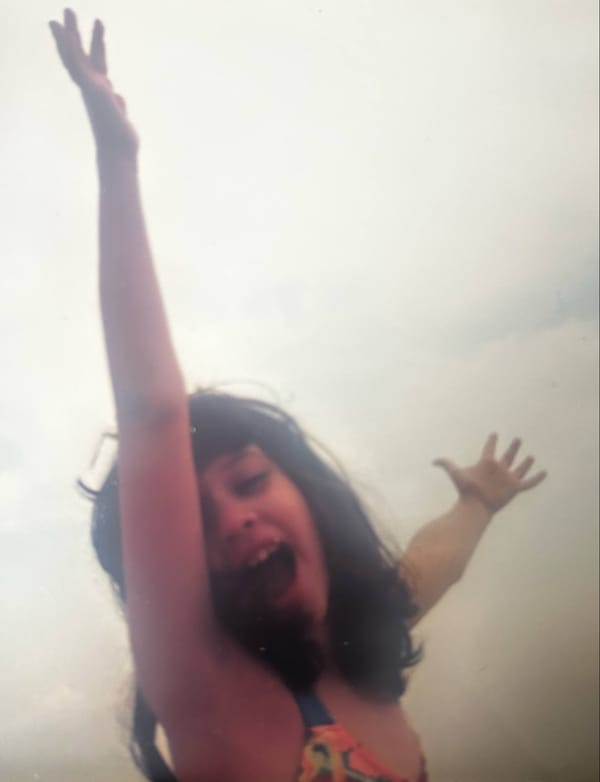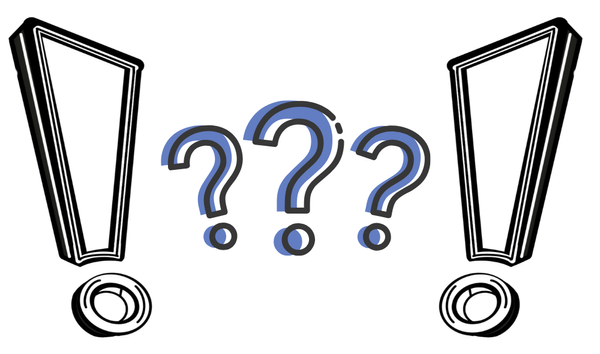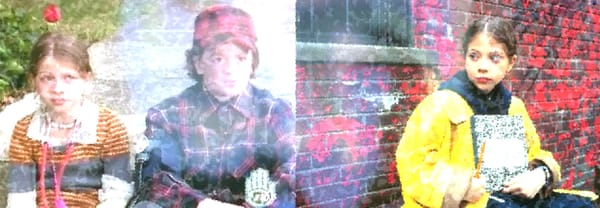An Open Love Letter to Pro Wrestling
A love letter to pro-wrestling and the worlds it creates.

Musings of an Anxious Millennial Writer #17: In Meteoras and In Mental Health
I’m a mark.
There’s I’ve said it. Do I like to think I’m a smart mark? Sure, just as any mark (smark) does. And yes, I like to distinguish myself as being slightly more elevated in my fandom. I can separate fact from fiction without it having any impact on my enjoyment of the show. I can admit that it’s “fake” in that the outcomes are (mostly) predetermined. I can get annoyed at the dirt sheets who report on all the false or exaggerated injuries as hard and fast news. Yes, I can acknowledge that it is, for all intents and purposes, theater.
But God do I love it. And really, what part of our lives isn’t theater?
Maybe part of the reason I love wrestling so much is that I’m a relative newbie to it. I didn’t grow up watching or adoring wrestling. I haven’t had the chance yet to fall out of love with it. When I was about 10 or 11, the granddaughter of one of my mom’s co-workers was obsessed with The Rock and would proceed to explain to me whatever ongoing storyline was happening at that time. I had no interest, to me it sounded like the soap operas my mom and grandma watched that I found boring, but with large beefy men. It wasn’t for me, and this was a notion I took with me for the next few decades.
I mostly avoided wrestling beyond that, only ever hearing it in conversations between ex-boyfriends and their guy friends, male co-workers, and miscellaneous chatter at punk shows. The more I’d hear these conversations take place, knowing I couldn’t contribute, the more it furthered my dislike of wrestling. It was like an inclusive club that I wasn’t invited to, and there were enough of those already in existence. I didn’t watch Star Wars until I was an adult. I wasn’t interested in shows like Lost or The Wire. I, to this day, have never seen any of the Lord of the Rings movies. I couldn’t contribute to a lot of pop cultural conversations, and no one was ever as excited to chat about all things Dave Barry or Jack Handey as I was. Wrestling was another thing I was on the outside looking in on. Mostly, for the life of me, I couldn’t understand how grown-ass adults could take what I still considered to be beefy-boy-soap-operas seriously.
All it took was a global pandemic and a series of lockdowns, isolation, and fear to change my mind.
Welcome to the Thunderdome
Nothing pains me more than revisiting the lockdowns of 2020. We were all there. If we were doing it right, we all remember how simultaneously boring and horrifying the experience was. For me, the isolation wasn’t the worst part. Already grappling with uncertainty about where my time was being spent and who it was being spent on, time forced in isolation with just my husband came as a welcome respite. Unfortunately, my daily fear of the actual pandemic and my doom-scrolling made me want less of a vacation from others and more of a vacation from my mind. Like many others, escapism reached an all-time high.
When faced with figuring out what to imbibe visually to try and quiet the noise of fear that Covid brought into my already panic-addled brain, the bevy of choices at our fingertips just added yet another task to my already overwhelmed self. After binge-watching The Adventures of Pete and Pete and To Catch a Predator (it’s weird what the heart wants when presented with unlimited options), my husband and I were left with the daunting task of figuring out what to watch next. A luxurious concern, but a concern, nonetheless.
“The WWE Network is offering a free trial, and we can watch Wrestlemania if you want,” my husband offered. He quelled his excitement at the possibility that maybe, just maybe, his wife would be interested, and he could pick up the fandom he left behind some 20 years earlier.
He was right. This was it. The time had come to welcome wrestling into my weary little heart. I mean, why not? What was there to lose? I needed something new to dive into and immerse myself in, assuming that I’d find it interesting enough to return to.
I’m not going to say I was immediately enraptured by my viewing of WrestleMania XXXVI, but I was curious. I also realized that the seemingly unending lore and soap opera-esque nature was more built up in my head than in reality. Yes, there is a ton of backstory, but no, you don’t need to watch all of it to enjoy two-to-eight men or women beating the living Hell out of each other. And I was also surprised to see just how realistic those beatings looked. I was convinced it would be more akin to my college’s play combat group’s displays than actual slobber knockers, but I was quickly proven wrong. I also thought Drew McIntyre looked delish, which certainly didn’t hurt.

But the newness of it, especially given the circumstances surrounding it (i.e. the goddamn global pandemic), the clean look, the lack of crowds, and the heavily sponsored moments made it feel like a dystopian future where humans are battling in cages for their hungry masses, serving their greedy, bloated masters. To combat this, I had to go to the archives. And so began my frequent viewing of ECW matches, taking a particular liking to Mick Foley, New Jack, Sandman, and Rob Van Dam. This unmitigated violence, the unhinged characters, and the feeling that anything could happen, for better or worse, drew me in. I was starting to think that I might just have it in me to become a wrestling fan.
There was something about that rawness, that pure unbridled violence, and the closeness to the audience that especially resonated with me at that time. People could touch each other. Sweat and blood dripped everywhere. Any issues you had with the other person, real or kayfabe (more on that later), you take it out in the ring. It felt like the ultimate release of tension, stress, and fear. What I wouldn’t give to have someone hit me in the head with a trash can, it would have woken me from the spell of fear and isolation.
In viewing it, I found some release. However, it also served as a stark reminder of where we were at that moment. For every large cheering audience, a new episode of RAW with its cast of wrestlers as a surrogate audience, before the even more dystopian Thunderdome-style camera setup, brought me firmly back into the present. Things were not as they once were, it was not the time of the Monday Night Wars or even the Attitude Era, two things I had never heard of while watching wrestling at that time. We were in 2020, and nothing was promised to us, except an increasingly digitized future where even your facial expressions could be thoroughly monitored.
I wasn’t about to give up, though.
I started boning up on my wrestling knowledge. Talking to friends and co-workers who were fans, asking for their favorite, can’t-miss matches. I started to learn the lingo; “marks” were the fans who couldn’t separate fact from fiction (a slope that’s slippery no matter how knowledgeable of a fan you are). “Heels” were the bad guys, but sometimes they were so good at being bad they’d get the biggest receptions (a “pop,” if you will). “Faces” were the good guys; unfortunately, often, they’re boring compared to the heels. “Kayfabe” is the act of upholding fiction as reality. A “work” is the fiction that’s upheld, a “shoot” is when what happens on camera is real (like two wrestlers taking real jabs at each other). I started to study some of the names of wrestling moves, but I’ll admit, to this day I still have a lot of learning to do there. As daunting as it seemed before I was in it, wrestling commentary usually does a great job of continuously educating fans on what moves and terms are, making it incredibly accessible to onboard new fans like me.
My decision to seek advice, read up on terminology, and educate myself on the past was exactly what I was trying to avoid before. I always felt that media consumption shouldn’t feel like homework, it should be what you do when you just want to turn your brain off. Sure, some media can challenge you, especially media that can reflect society and all its ills, but escapism should be easy. What I realized, though, is that I didn’t need to learn all the ins and outs of wrestling—the basics and it as a business—I wanted to.
I was hooked. But would it last?
An Alternative
“If you’ve been enjoying wrestling, you really ought to check out AEW,” my co-worker Stephen, one of my many sherpa-like guides in wrestling, informed me. In all my forays into wrestling’s past, I never thought about the present or looked enough into it to know what was going on. I knew WWE had three programs—RAW, Smackdown, and NXT. I was aware in my peripheral of NJPW. But AEW had somehow not made its way onto my radar.
That Wednesday, everything changed.
“Is that Chris Jericho?” I asked my husband, not so bold yet to confidentially call out a wrestler I recognized. “He’s like a big deal, right?”
“Yeah, this whole company is pretty legit,” he responded.
In those two hours, I was smitten. Despite the lack of audience and my personal questions and concerns for the wrestlers’ safety, I was getting everything I wanted out of wrestling. There was pure, unmitigated violence. There were high-flying spots. Meaty men were slapping meat. It was like a buffet of the best kinds of wrestling, all piled high on my plate. There was comedy, drama, and storylines that pulled me in. This was what I was looking for, and week after week it delivered on that promise. I finally found the escapism I needed at a time when I needed it the most. Wednesdays became more than just another day in the continuous Groundhog Day-like existence of work, eat, worry, and sleep. It was now filled with Dynamite.

But it wasn’t wrestling that my life was missing; it was the joie de vivre of discovering—and falling in love with—something new. It was the honest-to-goodness excitement that comes with fandom, something I hadn’t experienced since my teenage years. Working in comics, I’m no stranger to fandom. Yet, when my work is rooted in fandom and escapism, they both become just that—work. No matter how much I enjoy what I do, it’s hard to separate work from fun when it comes to media consumption. Wrestling reminded me, at the time a 32-year-old woman, that you’re never too old to get swept up in the chaotic energy of fandom. Moreso than that, it feels nice to be on the inside. To share joy with others, to have something in common with a group of people, felt like a warm, comfy blanket. Especially at a time when it was impossible to share moments with others, finding security in fandom was a close to feeling human again as possible.
But sometimes reality and escapism intertwine—both for better and for worse.
I was already enthralled with the product when the debut of a new-to-the-promotion wrestler firmly cemented my love of the sport: Eddie Kingston.
“Check it out, this guy’s from Yonkers,” my husband informed me. A guy from my hometown? He’d have my support without question.
But it wasn’t just a matter of him being from my hometown, he’s SO obviously from my hometown it almost hurts. He sounds like everyone I know. His DGAF attitude and fly-off-the-handle-at-any-inconvenience nature remind me of so many people I know. How could I NOT root for him?
Eddie Kingston also broke the mold for several reasons: he was new to AEW but by no means new to wrestling, a nearly 20-year veteran who almost quit because it wasn’t taking off to go back to welding, who got one last chance at making this happen and managed to, despite perpetually being the underdog, galvanize legions of people behind him to root for him to his now (at the time of writing this) triple crown status. (Editor’s note: He has since dropped two of the three belts, but he’ll always be a triple crown champ in my heart.)

But it’s not just his story and his character arcs that are compelling, it’s his willingness to discuss his struggles with mental health, blurring those lines between real and kayfabe to put his most authentic self out there, even if it’s him amped up to 11. That’s what I love the most about Eddie, his “character” is just himself, a dude from Yonkers. What’s continually mind-blowing is how much people get it. It makes the most sense to me, I’m just a “Yonkers bum” myself, and Eddie is DRIPPING in what you could only describe as “Yonkers.” But there’s something so universal about the underdog, the guy whose hometown brought him to the brink of destruction, but he can’t shake it off as a part of him. That’s what’s so relatable and resonates.
And where else can you find that kind of story except for in wrestling? When I’m questioning if I should keep going, struggling with my own good and bad days, these wrestlers not only put their bodies on the line for my entertainment, but also being open and honest and willing to tear down those walls, or at very least build believable characters out of real-world issues, can only exist in the world of sports entertainment. Whether it’s Eddie’s open talks about mental health, Hangman Adam Page’s Anxious Millennial Cowboy character, or even MJF’s “is this true or storyline?” tales of his own personal struggles, wrestling made me realize that it’s okay to not be okay.
I talk a lot about my own mental health struggles. I don’t want to stop, there’s something so gratifying about people letting me know I’m not alone in these. But sometimes I wonder if I’m being too vulnerable, too raw, too emotional. Wrestling has taught me that’s not the case. If you can’t be yourself, well, be a really good avatar of yourself that can speak those words you might not feel comfortable saying outright.
Dark Side of the Ring
Eventually, the world reopened. And my love of wrestling only grew now that I could attend wrestling shows in person. There’s nothing quite like the adrenaline rush of a live wrestling show, especially for an indie promotion. It’s a lot like going to a punk show, the crowd is electric, the vibe is aggressive in the best ways, sweat warms everyone in the room, and we're all in it together, even if we’re not rooting for the same people. From major events to indies, going to a live show makes me feel like I’m a teen again, watching my favorite band play in an arena or at a local high school auditorium. So much of fandom is in nostalgia—both in what we like and what it makes us feel like. People so often collect toys, watch wrestling, and read comic books because it reminds them of a point in time when things were simpler.

Unfortunately, as an adult, things aren’t simple. And neither is the real-world aspect of wrestling.
I, like anyone who even has a marginal knowledge of wrestling, have followed the ongoing Vince McMahon news. How could I not? It’s horrifying, upsetting, and to anyone who knows anything about McMahon and the business he ran, not surprising. The nature of kayfabe vs. reality was never more dangerously utilized than in airing McMahon’s dirty deeds on a public level under the “Mr. McMahon” character. A heel both in reality and kayfabe, it’s easy to lay all the blame squarely on him.
But it’s not just him, it’s a culture that allows people like him to not only survive but thrive. It’s a culture of “locker room talk” and “boys-only clubs” that continue to present “the good old days” as better than the present. Where nostalgia reminds us of a simpler time, it also harkens back to a darker period, a time when women were there for the male gaze, and only the toughest men could win, the muscly guys who would rather kill than share with the world a moment of raw honesty. It reminds me of all the exclusive clubs I was never a part of and why I rejected them for so long. And when wrestling fans push for a return to that, or continue to endorse it because it’s easier to pretend it’s all kayfabe than allow us to look at our fandom under a critical lens, we see both the danger of the elusive nature of nostalgia and fandom—when escapism goes so far we refuse to accept reality at all. When we, too, become worked.
So where do we go from there?
Sure, wrestling isn’t all sunshine and rainbows. Like anything in life, it’s got its nefarious underbelly that rears its ugly head from time to time. There are also plenty of people within the industry putting in the work to change it, to keep it moving into the future despite certain fans’ pleas to have it go back into the past. Into a time when women were merely just props. When men didn’t share their feelings. And when body types and presentation ruled. I, for one, am glad to see wrestlers and the newest generations of fans tearing down those walls. I can both support the folks pushing for change and hold others staying silent accountable, without giving up on it. Being a fan does not have to mean never being critical—in fact, quite the opposite. But use your voice for the greater good, not to bully wrestlers that you don’t like based on storylines.
Working in comics can often feel a lot like working in wrestling. In fact, a lot of work is like wrestling. Come to think of it, everything is kind of like wrestling. Everyone’s looking for “the bag.” People will sacrifice their morals just for “the business.”
We’re in an election year—you won’t find anything more like wrestling than the promo-offs of debates, the mud-slinging campaigns, and the Tom and Jerry and heel vs. face nature of electoral politics. Except the stakes are much higher… and yet the performers for the most part are just as ludicrous, and oftentimes performing in kayfabe.
…Ok, that’s not a comforting comparison. Thankfully, I can escape to actual pro wrestling to take my mind off it.



